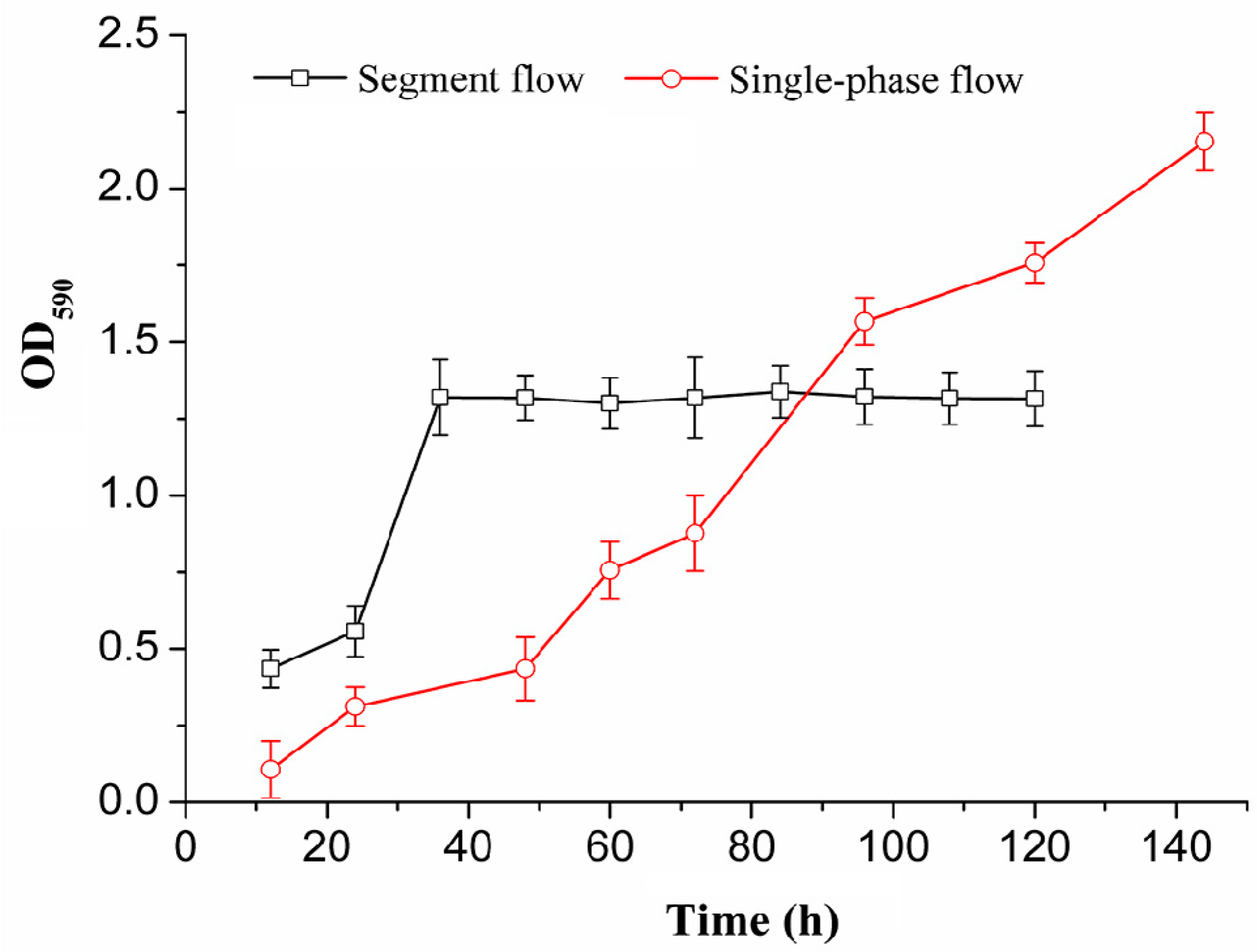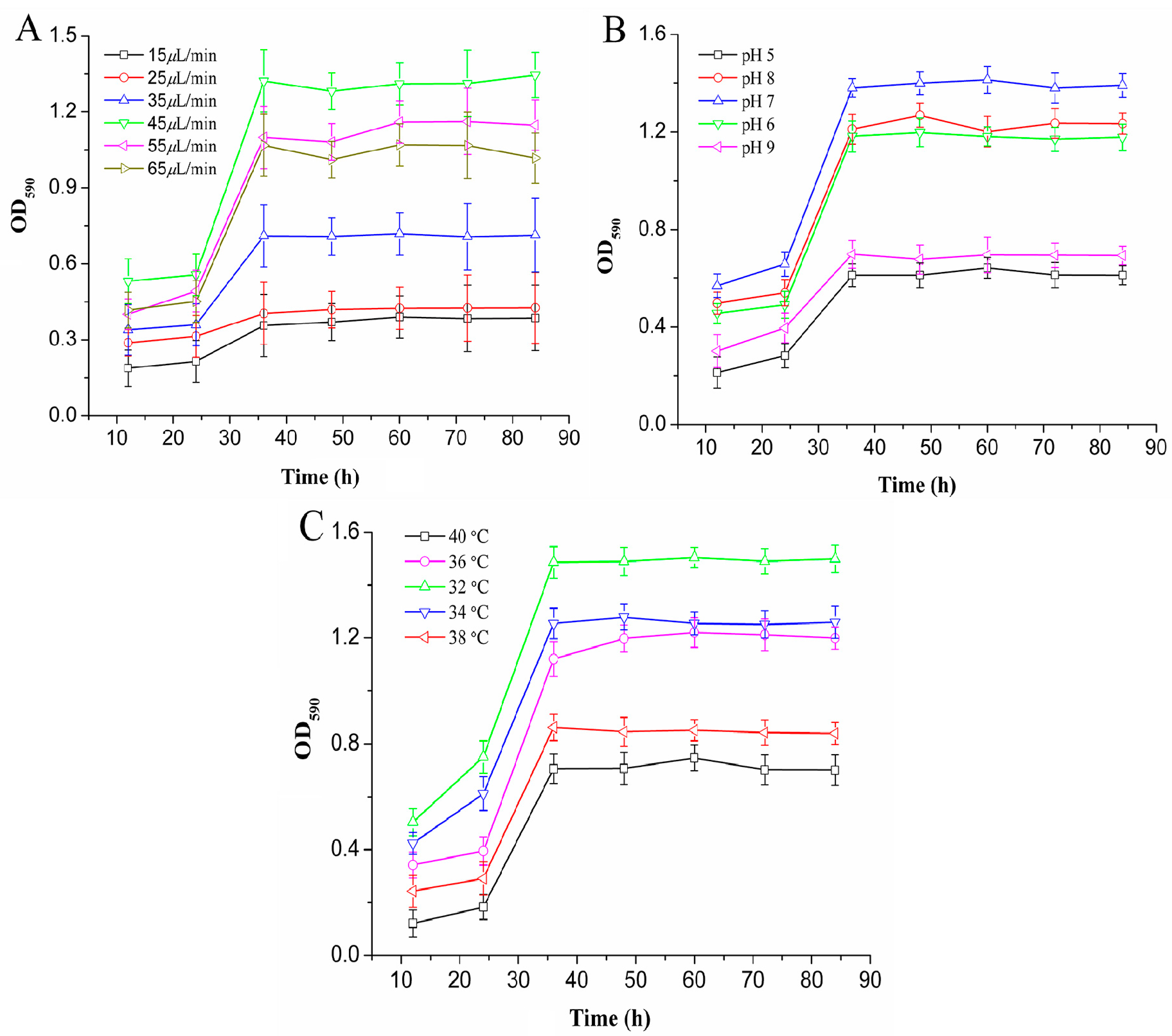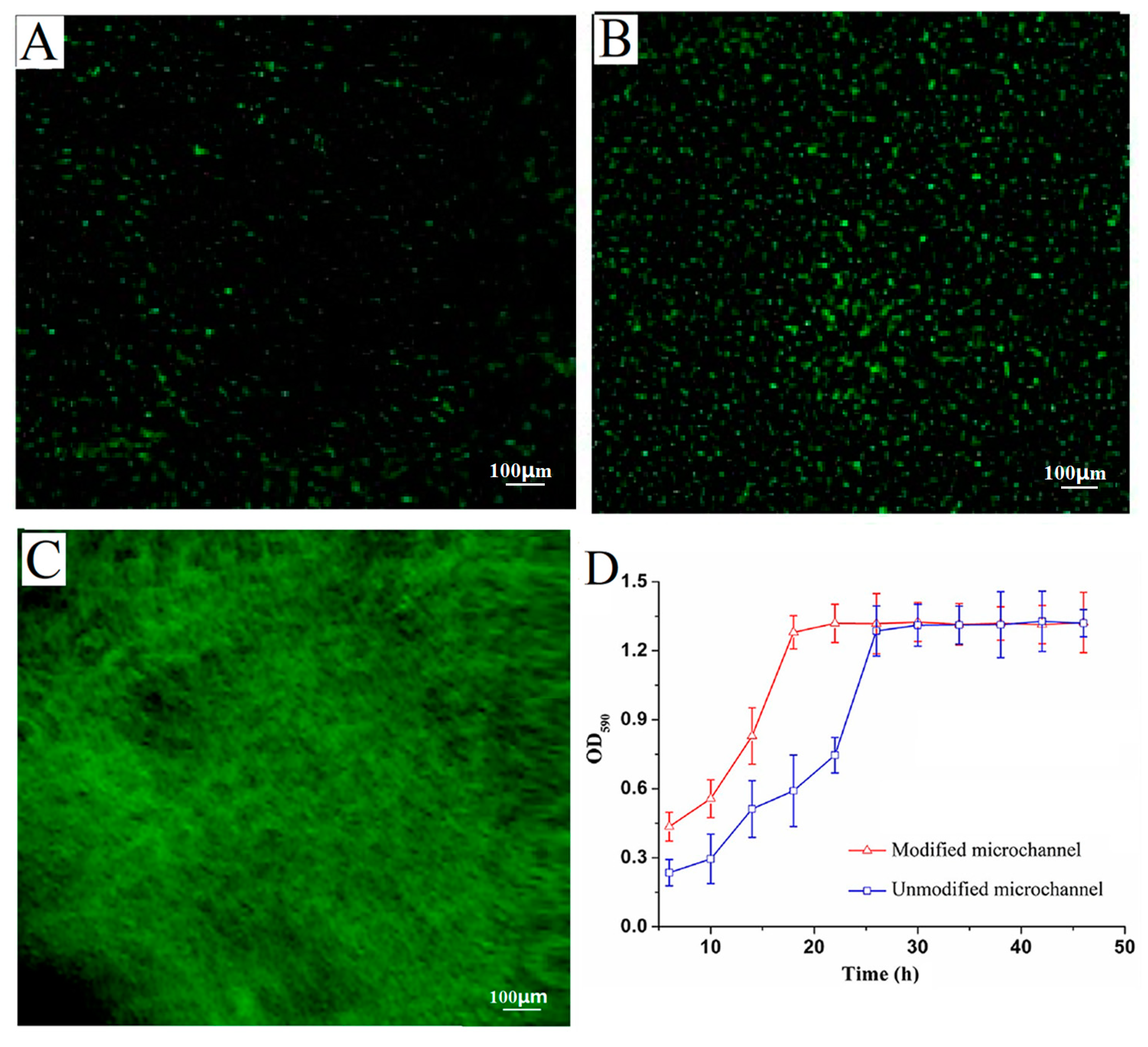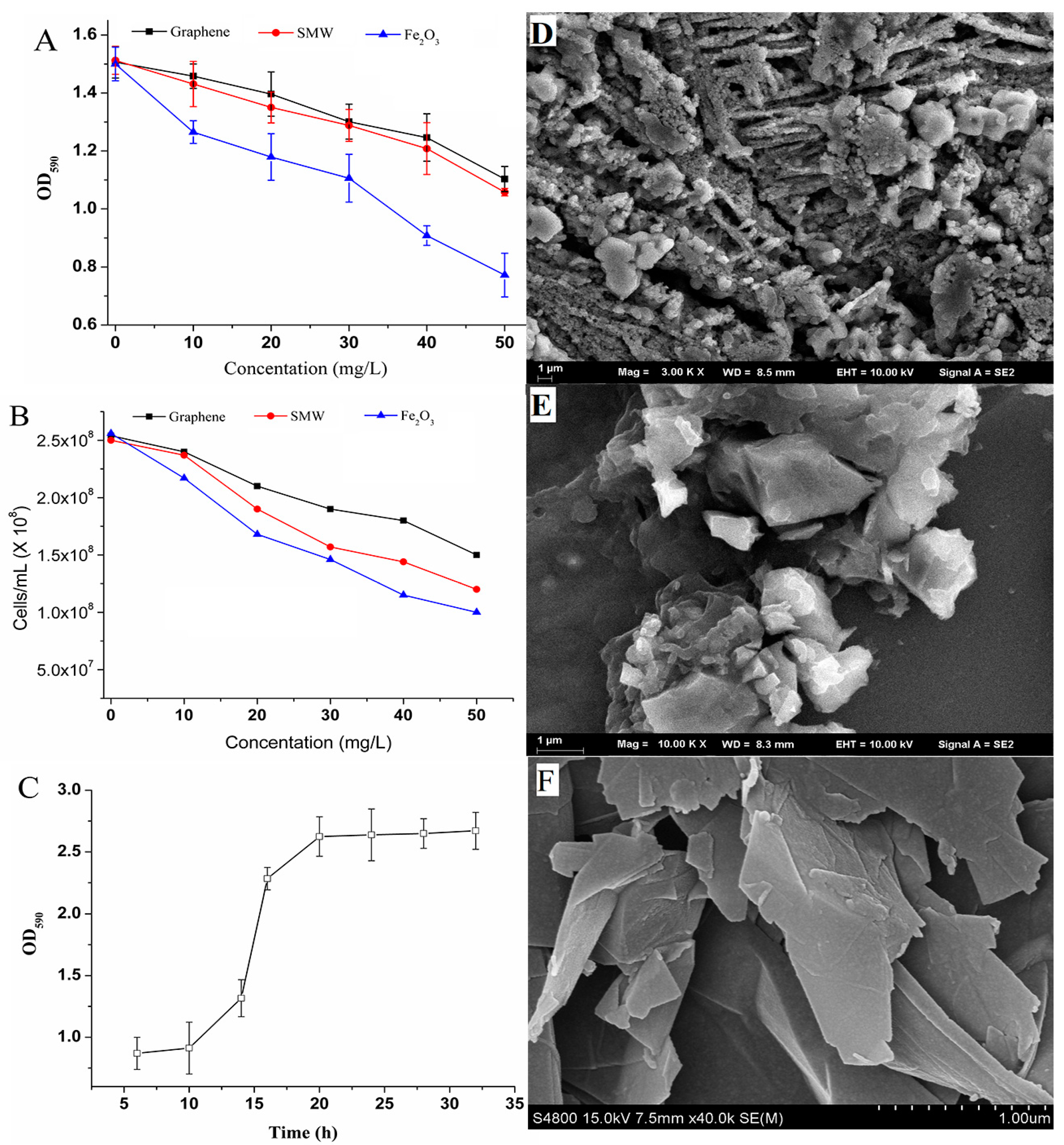Recombinant Escherichia coli BL21-pET28a-egfp Cultivated with Nanomaterials in a Modified Microchannel for Biofilm Formation
Abstract
:1. Introduction
2. Results and Discussion
2.1. Biofilm Growth Under Segmented Flow and Single Phase Flow Modes
2.2. Biofilm Cultivation in the Microchannel Reactor
2.3. Effect of Channel Surface Modification on Cell Immobilization and Biofilm Formation
2.4. Biofilm Cultivation with Nanomaterials
2.5. Characterization of Biofilm
3. Materials and Methods
3.1. Materials
3.2. Surface Modification and Immobilization of the Strain in the Microreactors
3.3. Recombinant E. coli Strains and Cultivation
3.4. Growth of E. coli and Biofilm
3.5. Total Biomass Assay of E. coli Biofilm
3.6. Biofilm Cultivation by LB Culture Medium with Nanomaterials in Microchannels
3.7. Characterization Analysis
3.8. Statistical Analysis
4. Conclusions
Supplementary Materials
Author Contributions
Funding
Conflicts of Interest
References
- Sutherland, I.W. Biofilm exopolysaccharides: A strong and sticky framework. Microbiology 2001, 147, 3–9. [Google Scholar] [CrossRef] [PubMed]
- Rosche, B.; Li, X.Z.; Hauer, B.; Schmid, A.; Buehler, K. Microbial biofilms: A concept for industrial catalysis? Trends Biotechnol. 2009, 27, 636–643. [Google Scholar] [CrossRef] [PubMed]
- Vu, B.; Chen, M.; Crawford, R.J.; Ivanova, E.P. Bacterial extracellular polysaccharides involved in biofilm formation. Molecules 2009, 14, 2535–2554. [Google Scholar] [CrossRef] [PubMed]
- Maksimova, Y.G. Microbial biofilms in biotechnological processes. Appl. Biochem. Microbiol. 2014, 50, 750–760. [Google Scholar] [CrossRef]
- Qureshi, N.; Annous, B.A.; Ezeji, T.C.; Karcher, P.; Maddox, I.S. Biofilm reactors for industrial bioconversion processes: Employing potential of enhanced reaction rates. Microb. Cell Fact. 2005, 4, 1–21. [Google Scholar] [CrossRef] [PubMed]
- Al-Kaidy, H.; Duwe, A.; Huster, M.; Muffler, K.; Schlegel, C.; Sieker, T.; Stadtmüller, R.; Tippkötter, N.; Ulber, R. Biotechnology and bioprocess engineering-from the first ullmann’s article to recent trends. Chembioeng. Rev. 2015, 2, 175–184. [Google Scholar] [CrossRef]
- Laurenti, E., Jr.; dos Santos Vianna, A. Enzymatic microreactors in biocatalysis: History, features, and future perspectives. Biocatalysis 2016, 1, 148–165. [Google Scholar] [CrossRef]
- Wörz, O.; Jäckel, K.P.; Richter, T.; Wolf, A. Microreactors, a new efficient tool for optimum reactor design. Chem. Eng. Sci. 2001, 56, 1029–1033. [Google Scholar]
- Karande, R.; Schmid, A.; Buehler, K. Applications of multiphasic microreactors for biocatalytic reactions. Org. Process Res. Dev. 2016, 20, 361–370. [Google Scholar] [CrossRef]
- David, C.; Bühler, K.; Schmid, A. Stabilization of single species synechocystis biofilms by cultivation under segmented flow. J. Ind. Microbiol. Biot. 2015, 42, 1083–1089. [Google Scholar] [CrossRef] [PubMed]
- Ng, J.F.; Jaenicke, S.; Eisele, K.; Dorn, J.; Weil, T. cBSA-147 for the preparation of bacterial biofilms in a microchannel reactor. Biointerphases 2010, 5, 41–47. [Google Scholar] [CrossRef] [PubMed]
- Karande, R.; Halan, B.; Schmid, A.; Buehler, K. Segmented flow is controlling growth of catalytic biofilms in continuous multiphase microreactors. Biotechnol. Bioeng. 2014, 111, 1831–1840. [Google Scholar] [CrossRef] [PubMed]
- Marsh, P.D. Dental plaque as a biofilm and a microbial community-implications for health and disease. BMC Oral Health 2015, 57, 185–191. [Google Scholar] [CrossRef] [PubMed]
- Li, X.Z.; Hauer, B.; Rosche, B. Single-species microbial biofilm screening for industrial applications. Appl. Microbiol. Biotechnol. 2007, 76, 1255–1262. [Google Scholar] [CrossRef] [PubMed]
- Stojkovič, G.; Krivec, M.; Vesel, A.; Marinšek, M.; Žnidaršič-Plazl, P. Surface cell immobilization within perfluoroalkoxy microchannels. Appl. Surf. Sci. 2014, 320, 810–817. [Google Scholar]
- Miyazaki, M.; Maeda, H. Microchannel enzyme reactors and their applications for processing. Trends Biotechnol. 2006, 24, 463–470. [Google Scholar] [CrossRef] [PubMed]
- Feng, W.; Ji, P. Enzymes immobilized on carbon nanotubes. Biotechnol. Adv. 2011, 29, 889–895. [Google Scholar] [CrossRef] [PubMed]
- Ramakrishna, T.; Nalder, T.; Yang, W.; Marshall, S.; Barrow, C.J. Controlling enzyme function through immobilisation on graphene, graphene derivatives and other two dimensional nanomaterials. J. Mater. Chem. B 2018, 6, 3200–3218. [Google Scholar] [CrossRef]
- Deep, A.; Sharma, A.L.; Kumar, P. Lipase immobilized carbon nanotubes for conversion of Jatropha oil to fatty acid methyl esters. Biomass Bioenergy 2015, 81, 83–87. [Google Scholar] [CrossRef]
- Bryers, J.; Characklis, W. Early fouling biofilm formation in a turbulent flow system: Overall kinetics. Water Res. 1981, 15, 483–491. [Google Scholar] [CrossRef]
- Kumar, R.V.; Raza, G. Photocatalytic disinfection of water with Ag-TiO nanocrystalline composite. Ionics 2009, 15, 579–587. [Google Scholar] [CrossRef]
- Halan, B.; Buehler, K.; Schmid, A. Biofilms as living catalysts in continuous chemical syntheses. Trends Biotechnol. 2012, 30, 453–465. [Google Scholar] [CrossRef] [PubMed]
- Paul, E.; Ochoa, J.C.; Pechaud, Y.; Liu, Y.; Liné, A. Effect of shear stress and growth conditions on detachment and physical properties of biofilms. Water Res. 2012, 46, 5499–5508. [Google Scholar] [CrossRef] [PubMed]
- Patil, S.A.; Harnisch, F.; Koch, C.; Hübschmann, T.; Fetzer, I.; Carmonamartínez, A.A.; Müller, S.; Schröder, U. Electroactive mixed culture derived biofilms in microbial bioelectrochemical systems: The role of pH on biofilm formation, performance and composition. Bioresour. Technol. 2011, 102, 9683–9690. [Google Scholar] [CrossRef] [PubMed]
- Giaouris, E.; Chorianopoulos, N.; Nychas, G.J. Effect of temperature, pH, and water activity on biofilm formation by Salmonella enterica enteritidis PT4 on stainless steel surfaces as indicated by the bead vortexing method and conductance measurements. J. Food. Prot. 2005, 68, 2149–2154. [Google Scholar] [CrossRef] [PubMed]
- Zhan, H.W.; Gang, J. Covalent immobilization of proteins for the biosensor based on imaging ellipsometry. J. Immunol. Methods 2004, 285, 237–243. [Google Scholar]
- Ohashi, A.; Harada, H. A novel concept for evaluation of biofilm adhesion strength by applying tensile force and shear force. Water Sci. Technol. 1996, 34, 201–211. [Google Scholar] [CrossRef]
- Halan, B.; Karande, R.; Buehler, K.; Schmid, A. Catalytic Pseudomonas taiwanensis VLB120ΔC biofilms thrive in a continuous pure styrene generated by multiphasic segmented flow in a capillary microreactor. J. Flow Chem. 2016, 6, 39–42. [Google Scholar] [CrossRef]
- Rodrigues, D.F.; Elimelech, M. Toxic effects of single-walled carbon nanotubes in the development of E. coli biofilm. Environ. Sci. Technol. 2010, 44, 4583–4589. [Google Scholar] [CrossRef] [PubMed]
- Willrodt, C.; Halan, B.; Karthaus, L.; Rehdorf, J.; Julsing, M.K.; Buehler, K.; Schmid, A. Continuous multistep synthesis of perillic acid from limonene by catalytic biofilms under segmented flow. Biotechnol. Bioeng. 2016, 114, 281–290. [Google Scholar] [CrossRef] [PubMed]
- Li, X.Z.; Webb, J.S.; Kjelleberg, S.; Rosche, B. Enhanced benzaldehyde tolerance in Zymomonas mobilis biofilms and the potential of biofilm applications in fine-chemical production. Appl. Environ. Microb. 2006, 72, 1639–1644. [Google Scholar] [CrossRef] [PubMed]
- Sinha, S.D.; Chatterjee, S.; Maity, P.K.; Tarafdar, S.; Moulik, S.P. Studies of protein adsorption on implant materials in relation to biofilm formation I. Activity of Pseudomonas aeruginosa on polypropylene and high density polyethylene in presence of serum albumin. arXiv, 2014; arXiv:1411.5108. [Google Scholar]
- Fabrega, J.; Fawcett, S.R.J.; Renshaw, C.; Lead, J.R. Silver nanoparticle impact on bacterial growth: Effect of pH, concentration, and organic matter. Environ. Sci. Technol. 2009, 43, 7285–7290. [Google Scholar] [CrossRef] [PubMed]
- Király, Z.; El-Zahaby, H.M.; Klement, Z. Role of extracellular polysaccharide (EPS) slime of plant pathogenic bacteria in protecting cells to reactive oxygen species. J. Phytopathol. 1997, 145, 59–68. [Google Scholar]
- Strankowski, M.; Piszczyk, A.; Strankowska, J. Polyurethane nanocomposites containing reduced graphene oxide, FTIR, Raman, and XRD studies. J. Spectrosc. 2016, 2016, 1–6. [Google Scholar] [CrossRef]
- Prabhawathi, V.; Boobalan, T.; Sivakumar, P.M.; Doble, M. Functionalized polycaprolactam as an active food package for antibiofilm activity and extended shelf life. Colloids Surf. B Biointerfaces 2014, 123, 461–468. [Google Scholar] [CrossRef] [PubMed]
- Chen, Y.; Zhang, X.; Tian, Y.; Zhao, X. Synthesis and characterization of silicon nanoparticles inserted into graphene sheets as high performance anode material for lithium ion batteries. J. Nanomater. 2014, 2014, 1–6. [Google Scholar] [CrossRef]
- O’Toole, G.A.; Kolter, R. Initiation of biofilm formation in Pseudomonas fluorescens WCS365 proceeds via multiple, convergent signalling pathways: A genetic analysis. Mol. Microbiol. 1998, 28, 449–461. [Google Scholar]





| Aqueous Flow Rate (μL/min) | Air Flower Rate (μL/min) | OD590 |
|---|---|---|
| 45 | 45 | 1.431 ± 0.052 |
| 45 | 55 | 1.492 ± 0.046 |
| 45 | 75 | 1.729 ± 0.049 |
| 45 | 95 | 1.828 ± 0.069 |
| 45 | 180 | 1.837 ± 0.051 |
| Nanometer Materials | Diameter (nm) | Length (μm) | Density (g/cm3) |
|---|---|---|---|
| Short-multiwalled carbon nanotube | 20–30 | 0.5–2 | 1.68 |
| Fe2O3 | - | 30–50 | 5.18 |
| Graphene | 0.55–1.2 | 0.5–3 | 0.77 |
© 2018 by the authors. Licensee MDPI, Basel, Switzerland. This article is an open access article distributed under the terms and conditions of the Creative Commons Attribution (CC BY) license (http://creativecommons.org/licenses/by/4.0/).
Share and Cite
Zhu, C.-T.; Mei, Y.-Y.; Zhu, L.-L.; Xu, Y.; Sheng, S.; Wang, J. Recombinant Escherichia coli BL21-pET28a-egfp Cultivated with Nanomaterials in a Modified Microchannel for Biofilm Formation. Int. J. Mol. Sci. 2018, 19, 2590. https://doi.org/10.3390/ijms19092590
Zhu C-T, Mei Y-Y, Zhu L-L, Xu Y, Sheng S, Wang J. Recombinant Escherichia coli BL21-pET28a-egfp Cultivated with Nanomaterials in a Modified Microchannel for Biofilm Formation. International Journal of Molecular Sciences. 2018; 19(9):2590. https://doi.org/10.3390/ijms19092590
Chicago/Turabian StyleZhu, Chang-Tong, Yi-Yuan Mei, Lin-Lin Zhu, Yan Xu, Sheng Sheng, and Jun Wang. 2018. "Recombinant Escherichia coli BL21-pET28a-egfp Cultivated with Nanomaterials in a Modified Microchannel for Biofilm Formation" International Journal of Molecular Sciences 19, no. 9: 2590. https://doi.org/10.3390/ijms19092590
APA StyleZhu, C.-T., Mei, Y.-Y., Zhu, L.-L., Xu, Y., Sheng, S., & Wang, J. (2018). Recombinant Escherichia coli BL21-pET28a-egfp Cultivated with Nanomaterials in a Modified Microchannel for Biofilm Formation. International Journal of Molecular Sciences, 19(9), 2590. https://doi.org/10.3390/ijms19092590







